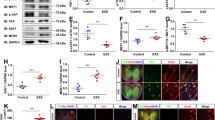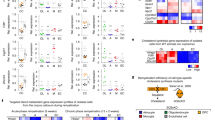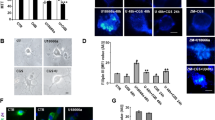Abstract
Oligodendrocytes (OLs) are glial cells that ensheath neuronal axons and form myelin in the central nervous system (CNS). OLs are differentiated from oligodendrocyte precursor cells (OPCs) during development and myelin repair, which is often insufficient in the latter case in demyelinating diseases such as multiple sclerosis (MS). Many factors have been reported to regulate OPC-to-OL differentiation, including a number of G protein-coupled receptors (GPCRs). In an effort to search pathways downstream of GPCRs that might be involved in OPC differentiation, we discover that U73122, a phosphoinositide specific phospholipase C (PI-PLC) inhibitor, dramatically promotes OPC-to-OL differentiation and myelin regeneration in experimental autoimmune encephalomyelitis model. Unexpectedly, U73343, a close analog of U73122 which lacks PI-PLC inhibitory activity also promotes OL differentiation, while another reported PI-PLC inhibitor edelfosine does not have such effect, suggesting that U73122 and U73343 enhance OPC differentiation independent of PLC. Although the structures of U73122 and U73343 closely resemble 17β-estradiol, and both compounds do activate estrogen receptors Erα and Erβ with low efficacy and potency, further study indicates that these compounds do not act through Erα and/or Erβ to promote OPC differentiation. RNA-Seq and bioinformatic analysis indicate that U73122 and U73343 may regulate cholesterol biosynthesis. Further study shows both compounds increase 14-dehydrozymostenol, a steroid reported to promote OPC differentiation, in OPC culture. In conclusion, the aminosteroids U73122 and U73343 promote OPC-to-OL generation and myelin formation by regulating cholesterol biosynthesis pathway.
This is a preview of subscription content, access via your institution
Access options
Subscribe to this journal
Receive 12 print issues and online access
$259.00 per year
only $21.58 per issue
Buy this article
- Purchase on Springer Link
- Instant access to full article PDF
Prices may be subject to local taxes which are calculated during checkout







Similar content being viewed by others
References
Simons M, Nave KA. Oligodendrocytes: myelination and axonal support. Cold Spring Harb Perspect Biol. 2015;8:a020479.
Popescu BF, Lucchinetti CF. Pathology of demyelinating diseases. Annu Rev Pathol. 2012;7:185–217.
Cayre M, Falque M, Mercier O, Magalon K, Durbec P. Myelin repair: from animal models to humans. Front Cell Neurosci. 2021;15:604865.
Fancy SPJ, Chan JR, Baranzini SE, Franklin RJM, Rowitch DH. Myelin regeneration: a recapitulation of development? Annu Rev Neurosci. 2011;34:21–43.
Kuhlmann T, Miron V, Cui Q, Wegner C, Antel J, Bruck W. Differentiation block of oligodendroglial progenitor cells as a cause for remyelination failure in chronic multiple sclerosis. Brain. 2008;131:1749–58.
Koutsoudaki PN, Papadopoulos D, Passias PG, Koutsoudaki P, Gorgoulis VG. Cellular senescence and failure of myelin repair in multiple sclerosis. Mech Ageing Dev. 2020;192:111366.
van Tilborg E, de Theije CGM, van Hal M, Wagenaar N, de Vries LS, Benders MJ, et al. Origin and dynamics of oligodendrocytes in the developing brain: Implications for perinatal white matter injury. Glia. 2018;66:221–38.
Bergles DE, Richardson WD. Oligodendrocyte development and plasticity. Cold Spring Harb Perspect Biol. 2015;8:a020453.
Bedner P, Jabs R, Steinhauser C. Properties of human astrocytes and NG2 glia. Glia. 2020;68:756–67.
Fang M, Yu Q, Ou B, Huang H, Yi M, Xie B, et al. Genetic evidence that dorsal spinal oligodendrocyte progenitor cells are capable of myelinating ventral axons effectively in mice. Neurosci Bull. 2020;36:1474–83.
Zhang SC. Defining glial cells during CNS development. Nat Rev Neurosci. 2001;2:840–3.
Santos AK, Vieira MS, Vasconcellos R, Goulart VAM, Kihara AH, Resende RR. Decoding cell signalling and regulation of oligodendrocyte differentiation. Semin Cell Dev Biol. 2019;95:54–73.
Takebayashi H, Ikenaka K. Oligodendrocyte generation during mouse development. Glia. 2015;63:1350–6.
Tyler WA, Gangoli N, Gokina P, Kim HA, Covey M, Levison SW, et al. Activation of the mammalian target of rapamycin (mTOR) is essential for oligodendrocyte differentiation. J Neurosci. 2009;29:6367–78.
Wang S, Sdrulla AD, diSibio G, Bush G, Nofziger D, Hicks C, et al. Notch receptor activation inhibits oligodendrocyte differentiation. Neuron. 1998;21:63–75.
Fancy SPJ, Baranzini SE, Zhao C, Yuk DI, Irvine KA, Kaing S, et al. Dysregulation of the Wnt pathway inhibits timely myelination and remyelination in the mammalian CNS. Gene Dev. 2009;23:1571–85.
Mogha A, D’Rozario M, Monk KR. G protein-coupled receptors in myelinating glia. Trends Pharmacol Sci. 2016;37:977–87.
Deshmukh VA, Tardif V, Lyssiotis CA, Green CC, Kerman B, Kim HJ, et al. A regenerative approach to the treatment of multiple sclerosis. Nature. 2013;502:327–32.
Mei F, Fancy SPJ, Shen YA, Niu J, Zhao C, Presley B, et al. Micropillar arrays as a high-throughput screening platform for therapeutics in multiple sclerosis. Nat Med. 2014;20:954–60.
Du C, Duan Y, Wei W, Cai Y, Chai H, Lv J, et al. Kappa opioid receptor activation alleviates experimental autoimmune encephalomyelitis and promotes oligodendrocyte-mediated remyelination. Nat Commun. 2016;7:11120.
Mei F, Mayoral SR, Nobuta H, Wang F, Desponts C, Lorrain DS, et al. Identification of the kappa-opioid receptor as a therapeutic target for oligodendrocyte remyelination. J Neurosci. 2016;36:7925–35.
Chen Y, Wu H, Wang S, Koito H, Li J, Ye F, et al. The oligodendrocyte-specific G protein-coupled receptor GPR17 is a cell-intrinsic timer of myelination. Nat Neurosci. 2009;12:1398–406.
Lu C, Dong L, Zhou H, Li Q, Huang G, Bai SJ, et al. G-protein-coupled receptor Gpr17 regulates oligodendrocyte differentiation in response to lysolecithin-induced demyelination. Sci Rep. 2018;8:4502.
Ou Z, Sun Y, Lin L, You N, Liu X, Li H, et al. Olig2-targeted G-protein-coupled receptor Gpr17 regulates oligodendrocyte survival in response to lysolecithin-induced demyelination. J Neurosci. 2016;36:10560–73.
Simon K, Hennen S, Merten N, Blattermann S, Gillard M, Kostenis E, et al. The orphan G protein-coupled receptor GPR17 negatively regulates oligodendrocyte differentiation via Galphai/o and its downstream effector molecules. J Biol Chem. 2016;291:705–18.
Yang HJ, Vainshtein A, Maik-Rachline G, Peles E. G protein-coupled receptor 37 is a negative regulator of oligodendrocyte differentiation and myelination. Nat Commun. 2016;7:10884–94.
Smith BM, Giddens MM, Neil J, Owino S, Nguyen TT, Duong D, et al. Mice lacking Gpr37 exhibit decreased expression of the myelin-associated glycoprotein MAG and increased susceptibility to demyelination. Neuroscience. 2017;358:49–57.
Meyer RC, Giddens MM, Schaefer SA, Hall RA. GPR37 and GPR37L1 are receptors for the neuroprotective and glioprotective factors prosaptide and prosaposin. Proc Natl Acad Sci USA. 2013;110:9529–34.
Raible DW, Mcmorris FA. Induction of oligodendrocyte differentiation by activators of adenylate-cyclase. J Neurosci Res. 1990;27:43–6.
Shin D, Lin ST, Fu YH, Ptacek LJ. Very large G protein-coupled receptor 1 regulates myelin-associated glycoprotein via Galphas/Galphaq-mediated protein kinases A/C. Proc Natl Acad Sci USA. 2013;110:19101–6.
Giera S, Deng YY, Luo R, Ackerman SD, Mogha A, Monk KR, et al. The adhesion G protein-coupled receptor GPR56 is a cell-autonomous regulator of oligodendrocyte development. Nat Commun 2015;6:6121–32.
Ackerman SD, Garcia C, Piao X, Gutmann DH, Monk KR. The adhesion GPCR Gpr56 regulates oligodendrocyte development via interactions with Galpha12/13 and RhoA. Nat Commun. 2015;6:6122.
Suo N, He B, Cui S, Yang Y, Wang M, Yuan Q, et al. The orphan G protein-coupled receptor GPR149 is a negative regulator of myelination and remyelination. Glia. 2022;70:1992–2008.
Marinissen MJ, Gutkind JS. G-protein-coupled receptors and signaling networks: emerging paradigms. Trends Pharmacol Sci. 2001;22:368–76.
Dikic I, Blaukat A. Protein tyrosine kinase-mediated pathways in G protein-coupled receptor signaling. Cell Biochem Biophys. 1999;30:369–87.
Chen Y, Balasubramaniyan V, Peng J, Hurlock EC, Tallquist M, Li J, et al. Isolation and culture of rat and mouse oligodendrocyte precursor cells. Nat Protoc. 2007;2:1044–51.
Guo YE, Suo N, Cui X, Yuan Q, Xie X. Vitamin C promotes oligodendrocytes generation and remyelination. Glia. 2018;66:1302–16.
Suo N, Guo YE, He B, Gu H, Xie X. Inhibition of MAPK/ERK pathway promotes oligodendrocytes generation and recovery of demyelinating diseases. Glia. 2019;67:1320–32.
Glatigny S, Bettelli E. Experimental autoimmune encephalomyelitis (EAE) as animal models of multiple sclerosis (MS). Cold Spring Harb Perspect Med. 2018;8:a028977.
Powis G, Seewald MJ, Gratas C, Melder D, Riebow J, Modest EJ. Selective inhibition of phosphatidylinositol phospholipase C by cytotoxic ether lipid analogues. Cancer Res. 1992;52:2835–40.
Bleasdale JE, Thakur NR, Gremban RS, Bundy GL, Fitzpatrick FA, Smith RJ, et al. Selective inhibition of receptor-coupled phospholipase C-dependent processes in human platelets and polymorphonuclear neutrophils. J Pharmacol Exp Ther. 1990;255:756–68.
Chan WS, Sideris A, Sutachan JJ, Montoya GJ, Blanck TJ, Recio-Pinto E. Differential regulation of proliferation and neuronal differentiation in adult rat spinal cord neural stem/progenitors by ERK1/2, Akt, and PLCgamma. Front Mol Neurosci. 2013;6:23.
Xiao J, Chen X, Xu L, Zhang Y, Yin Q, Wang F. PDGF regulates chondrocyte proliferation through activation of the GIT1- and PLCgamma1-mediated ERK1/2 signaling pathway. Mol Med Rep. 2014;10:2409–14.
Chen X, Wang Y, Chen R, Qu N, Zhang B, Xia C. Suppressing PLCgamma1 enhances osteogenic and chondrogenic potential of BMSCs. Biochem Biophys Res Commun. 2020;532:292–9.
Du Y, Lercher LD, Zhou R, Dreyfus CF. Mitogen-activated protein kinase pathway mediates effects of brain-derived neurotrophic factor on differentiation of basal forebrain oligodendrocytes. J Neurosci Res. 2006;84:1692–702.
Cenni B, Picard D. Two compounds commonly used for phospholipase C inhibition activate the nuclear estrogen receptors. Biochem Biophys Res Commun. 1999;261:340–4.
Gonzalez GA, Hofer MP, Syed YA, Amaral AI, Rundle J, Rahman S, et al. Tamoxifen accelerates the repair of demyelinated lesions in the central nervous system. Sci Rep. 2016;6:31599.
Jung-Testas I, Baulieu EE. Steroid hormone receptors and steroid action in rat glial cells of the central and peripheral nervous system. J Steroid Biochem Mol Biol. 1998;65:243–51.
Kuiper GG, Carlsson B, Grandien K, Enmark E, Haggblad J, Nilsson S, et al. Comparison of the ligand binding specificity and transcript tissue distribution of estrogen receptors alpha and beta. Endocrinology. 1997;138:863–70.
Hubler Z, Allimuthu D, Bederman I, Elitt MS, Madhavan M, Allan KC, et al. Accumulation of 8,9-unsaturated sterols drives oligodendrocyte formation and remyelination. Nature. 2018;560:372–6.
Jang HJ, Yang YR, Kim JK, Choi JH, Seo YK, Lee YH, et al. Phospholipase C-gamma1 involved in brain disorders. Adv Biol Regul. 2013;53:51–62.
McKinnon RD, Waldron S, Kiel ME. PDGF alpha-receptor signal strength controls an RTK rheostat that integrates phosphoinositol 3’-kinase and phospholipase Cgamma pathways during oligodendrocyte maturation. J Neurosci. 2005;25:3499–508.
Zhang Z, Cerghet M, Mullins C, Williamson M, Bessert D, Skoff R. Comparison of in vivo and in vitro subcellular localization of estrogen receptors alpha and beta in oligodendrocytes. J Neurochem. 2004;89:674–84.
Bosch RR, Patel AM, Van Emst-de Vries SE, Smeets RL, De Pont JJ, Willems PH. U73122 and U73343 inhibit receptor-mediated phospholipase D activation downstream of phospholipase C in CHO cells. Eur J Pharmacol. 1998;346:345–51.
Kato Y, Ochiai A, Seki Y, Morimoto T, Oizumi H, Ohbuchi K, et al. Phospholipase D and phosphatidylinositol-4-phosphate 5-kinase 1 are involved in the regulation of oligodendrocyte morphological differentiation. Exp Cell Res. 2021;405:112654.
Macrez-Lepretre N, Morel JL, Mironneau J. Effects of phospholipase C inhibitors on Ca2+ channel stimulation and Ca2+ release from intracellular stores evoked by alpha 1A- and alpha 2A-adrenoceptors in rat portal vein myocytes. Biochem Biophys Res Commun. 1996;218:30–4.
Cho H, Youm JB, Ryu SY, Earm YE, Ho WK. Inhibition of acetylcholine-activated K+ currents by U73122 is mediated by the inhibition of PIP2-channel interaction. Br J Pharmacol. 2001;134:1066–72.
Zhao N, Huang W, Catalin B, Scheller A, Kirchhoff F. L-Type Ca2+ channels of NG2 glia determine proliferation and NMDA receptor-dependent plasticity. Front Cell Dev Biol. 2021;9:759477.
Cheli VT, Santiago Gonzalez DA, Spreuer V, Paez PM. Voltage-gated Ca2+ entry promotes oligodendrocyte progenitor cell maturation and myelination in vitro. Exp Neurol. 2015;265:69–83.
Sax JL, Hubler Z, Allimuthu D, Adams DJ. Screening reveals sterol derivatives with pro-differentiation, pro-survival, or potent cytotoxic effects on oligodendrocyte progenitor cells. ACS Chem Biol. 2021;16:1288–97.
Kwong E, Li YZ, Hylemon PB, Zhou HP. Bile acids and sphingosine-1-phosphate receptor 2 in hepatic lipid metabolism. Acta Pharm Sin B. 2015;5:151–7.
Yu H, Rimbert A, Palmer AE, Toyohara T, Xia Y, Xia F, et al. GPR146 deficiency protects against hypercholesterolemia and atherosclerosis. Cell. 2019;179:1276–88.e14
Liu S, Gao Y, Zhang L, Yin Y, Zhang W. Rspo1/Rspo3‐LGR4 signaling inhibits hepatic cholesterol synthesis through the AMPKα‐SREBP2 pathway. FASEB J. 2020;34:14946–59.
Zhang Y, Zhu Z, Sun L, Yin W, Liang Y, Chen H, et al. Hepatic G protein-coupled receptor 180 deficiency ameliorates high fat diet-induced lipid accumulation via the Gi-PKA-SREBP pathway. Nutrients. 2023;15:1838–52.
Acknowledgements
This work was supported by grants from the Ministry of Science and Technology of China (STI2030 Major Projects 2022ZD0204700) and the National Natural Science Foundation of China (82121005, 82003723, 82330113).
Author information
Authors and Affiliations
Contributions
SHC conducted most of the experiments. The effect of U73122 and U73343 on OPC differentiation were discovered by NS. SHC and NS analyzed the results, and wrote the paper. YY performed the co-culture experiment and part of the OPC differentiation assay. XW performed part of the western blot analysis. SMG provided technical assistance in luciferase reporter assays and IP1 detection assay. XX conceived the idea for the project, analyzed the results, and wrote the paper. All authors reviewed the results and approved the manuscript.
Corresponding author
Ethics declarations
Competing interests
The authors declare no competing interests.
Rights and permissions
Springer Nature or its licensor (e.g. a society or other partner) holds exclusive rights to this article under a publishing agreement with the author(s) or other rightsholder(s); author self-archiving of the accepted manuscript version of this article is solely governed by the terms of such publishing agreement and applicable law.
About this article
Cite this article
Cui, Sh., Suo, N., Yang, Y. et al. The aminosteroid U73122 promotes oligodendrocytes generation and myelin formation. Acta Pharmacol Sin 45, 490–501 (2024). https://doi.org/10.1038/s41401-023-01183-7
Received:
Accepted:
Published:
Issue Date:
DOI: https://doi.org/10.1038/s41401-023-01183-7



